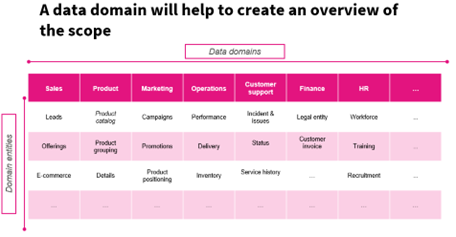Introducing data domain thinking as a no-regret move towards fixing messy data
25 November 2025

Even with big investments in data systems, many organizations still struggle with basic questions like “What’s the real number of active customers?” because their data is scattered and inconsistent. By organizing data around core business concepts like Customer or Product, companies can create clarity, ownership, and a strong foundation for better decisions and future data products.
Typical pain points
If you’re like most organisations we talk to, you’ve invested heavily in collecting, storing, processing and reporting on data, yet you’re still struggling with basic questions like:
- Why do different teams come up with deviating figures on the number of active customers?
- Why is the same product segmented in five different ways across systems?
- Why is it so hard to know in which application the “source of truth” lives?
Sound familiar? Then chances are your company suffers from a fragmented data landscape - costing you time, money & trust.
Many organisations grew their data landscape organically over time. Every new system, department or process brought its own database, definitions and interfaces. The result:
- Redundant data: the same information is stored and managed in multiple places, often slightly differently.
- No single source of truth: It’s unclear which system is master for a given piece of data.
- Fragmented ownership: nobody really “owns” the data, IT manages the platforms, business owns the processes, but the data itself falls through the cracks.
- High run cost: adding new capabilities & integrating new tools is time consuming and costs more. Teams are spending too much time firefighting to keep the light on.
- Low trust in data: steering meetings turn into data quality debates instead of decision-making sessions.
The real issue isn’t the technology. These are functional problems and they won’t be solved by adding yet another tool, database, or dashboard.
Enter data domain thinking – a first no-regret move to regain control of your data
The concept of data domains is simple but powerful: instead of organising your data landscape around applications or departments, you structure it around core business concepts like Customer, Product, Contract, Asset, Invoice, or Employee.
By doing so, you gain a bird’s-eye view of all your data — a structured, shared understanding of what exists, where it lives, and who owns it.
The benefits it brings:
- A shared language across data producers and consumers
Business and technical teams start speaking the same language. Everyone understands what data exists, how it’s defined, and how it’s used. This shared vocabulary eliminates ambiguity and fosters true collaboration. - Ownership and accountability
It helps to install clearly assigned data governance roles (ownership & stewardship) per data domain, so accountability stops falling through the cracks. - A foundation for your data products
Domain-based structuring provides the backbone for reliable, reusable foundational data products. Each use-case driven data product can build upon a clear, trusted dataset, accelerating everything from reporting to AI initiatives. - Improved discoverability and the “home page” of your data market place
A well-defined domain model becomes the entry point for all your data governance tooling. It’s the overview that helps users quickly find, understand and trust the data they need. - A prioritised roadmap and planning
With visibility across all domains, you can identify which ones are most fragmented or business-critical. This allows you to focus effort where it delivers the highest value — with a roadmap everyone aligns behind.
Data domain thinking isn’t about technology first. It’s about building a shared, structured understanding of your business data. It’s the first no-regret move to make a step-up in company-wide data management.
How we can help you make the shift
At Datashift, we guide organisations in taking the first tangible steps toward a domain-oriented data landscape.
Our approach is pragmatic & collaborative:
Step 1 – Create your shared data domain map
Together with business and IT, we define the core data domains that reflect your organisation’s key business concepts — Customer, Product, Contract, Asset, and more.
The outcome: a shared “bird’s-eye view” of your data — a simple, visual model that aligns everyone on what data exists, how it’s categorized in domains and how it’s defined (glossary).

Step 2 – Expose what’s really happening today
We then map your current applications, the current state of data and involved stakeholders against these domains. The result is an “x-ray” of your as-is data landscape:
- Where data is duplicated
- Where ownership is missing or unclear
- Where quality issues and inefficiencies originate

This exercise makes it clear where refactoring efforts will create the biggest rationalisation & efficiencies, leading to indirect business benefits.
Step 3 — Turn insight into action
Armed with your domain model and landscape map, we help you design a prioritised roadmap for change. Whether your next step is data consolidation, master data management, a new data platform, or defining your first set of data products — you’ll have a clear, business-driven blueprint to guide every decision.

Ready to start untangling your data landscape?
You don’t have to fix everything overnight. But you do need to start somewhere and introducing data domain thinking is the one move that never goes to waste.
If you recognise these challenges, let’s talk. We’ll help you bring structure, ownership and transparency back into your data so your teams can finally stop firefighting and start delivering value.

